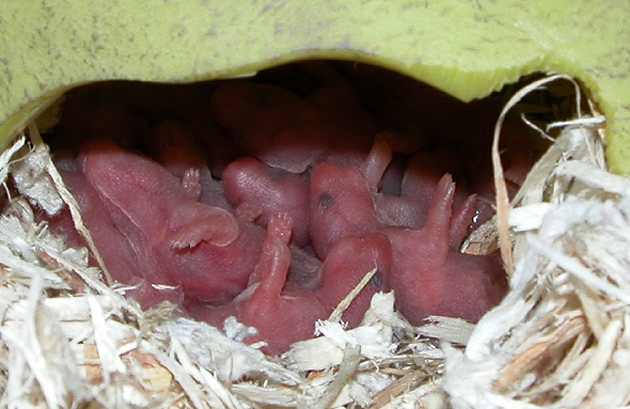|
1 OCTOBER 2004
A Peacemaker is Born

The blessed event happened on Saturday morning, the 25th of September, 2004. A litter of babies was born to newlyweds Cecil and Donna. The little ones' newborn photos, taken approximately 12 hours after their birth, captured the happy event for eternity.
Among the first to congratulate the couple on their new family was Potus, who is growing frail and tired with age, and is planning to retire at the upcoming Hamster For President political convention next month. After taking one look at these promising infants, Potus confidently said he was certain there was more than one deserving successor in their midst.
Proud mama Donna has promised to raise the young ones to be high achievers with the utter disdain for politics that goes into making the ideal presidential candidate. She pointed to one, a male, and said she was sure that he would be the next president of the United States. His name? In keeping with tradition, she has called him Diddley Squat V - the fifth in a long line of illustrious hamsters bearing the Diddley Squat name.
HAMSTER BABIES
Hamster babies are born 16 days after they are conceived. At birth, they are tiny, perhaps a centimeter in length. The photo above is enlarged. When first born, they have a dark red color. This is because their skin is so thin that the blood vessels actually make them appear reddish. Within hours, they begin to look more pink. To humans, they all look alike at this stage of life.
By the third or fourth day (see below), pigment in the skin begins to show up. Light colored hamsters will stay pinkish in color, while darker ones will have a deep, almost grayish tone of skin. They will start to stray from the nest when they reach about seven to nine days of age, even though their little eyes are still closed at this point. These week-old hamster babies will have soft, wet-looking baby fur that generally shows the colors they are when they are grown.

Cecil and Donna's babies at four days of age (enlarged X 4)
A BIG NEST
Baby hamsters require special care. This, of course, is provided by their mothers. But humans can help. The expectant mother should be placed in a clean cage a few days before her due date, with extra litter so that she can build a big nest. The deep litter helps in other ways, too. Since it's risky to disturb babies before they are weaned, the litter will get quite dirty as the young hamsters grow. It's best to change the cage litter three weeks after birth. It can be done at two weeks if it seems overly dirty. But every effort should be made to do so quickly and to preserve what can be saved of the old, familiar nest. Try to touch the babies as little as possible. They're still too young to be handled.
MILK FOR MOTHER AND BABIES
Maternity is also made easier by putting the expectant mother's cage in a dark, quiet spot and doing as little as possible to disturb her, both before and after delivery. An excellent way to help new mothers produce enough milk for their young without weakening them is to give supplemental formula to them in a dropper or syringe, starting at least two days before the expected birth. Good options are goat milk, which can be purchased dry (we use the Meyenberg brand) and mixed in small quantities. The mixed goat milk is stored in a small container in the refrigerator and warmed to room temperature before feeding. Powdered Isomil baby formula can be used the same way. Donna takes a 3 ML syringe half-full of milk four or five times a day. As the babies begin to start nibbling from the food dish, a "baby mix" can be made by combining the formula with dry baby cereal or the dust from "lab blocks" rodent food (Square Meal is one common brand).
THE WEANING STAGE
Baby hamsters don't really look like hamsters until they are three weeks old, at which time they are in the process of being weaned from mother's milk. They still need to stay with the mother a little longer, but at this age they can be briefly held to begin the process of taming them. Hold the young one very close to the ground in a place where it can't run under or behind furniture. Hamsters this age are jumpy and will certainly try to get away. By the age of five weeks, they are fully weaned and at the brink of adolesence. Gender can be detected and they should be separated from the mother, with the males put in a cage of their own and the females in another. Before long, each will need to live in his or her own solitary cage.
You will notice that we haven't said how many babies Cecil and Donna have. That's because there's no safe way to count them when they're small. As they begin leaving the nest, an early but tentative count can be made. And, of course, the census will be announced on this web page when it is known.
Don't miss any news from the Hamster For President campaign! You can receive automatic e-mail notices alerting you to changes made here. Just enter your email address.

|

